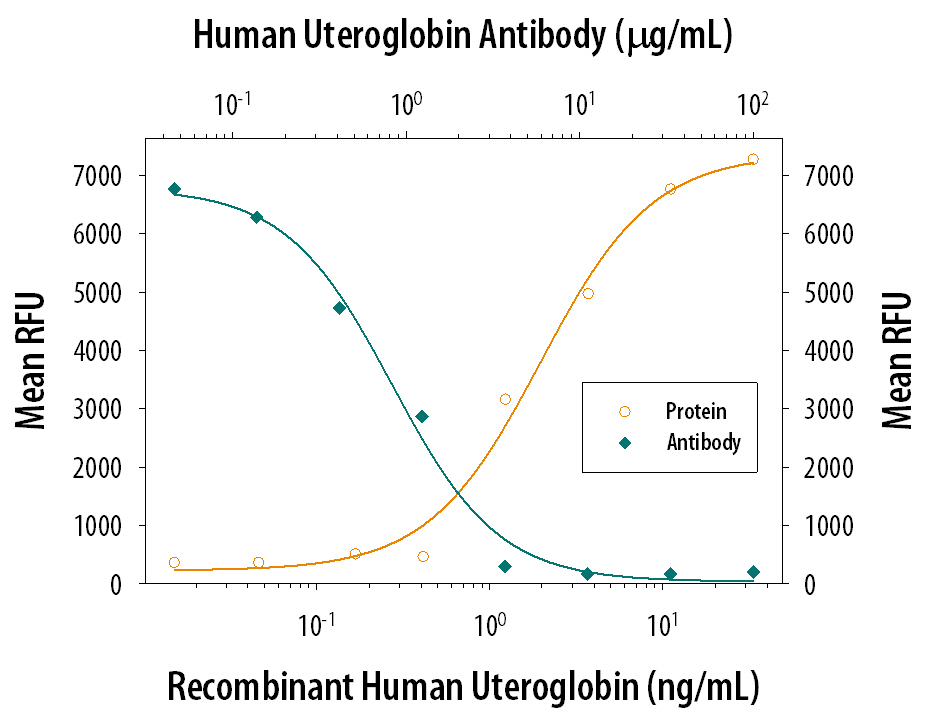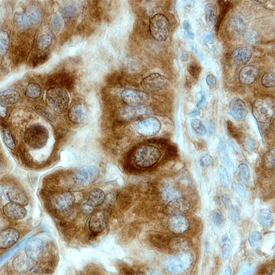Human Uteroglobin/SCGB1A1 Antibody Summary
Glu22-Asn91
Accession # NP_003348
Applications
Please Note: Optimal dilutions should be determined by each laboratory for each application. General Protocols are available in the Technical Information section on our website.
Scientific Data
 View Larger
View Larger
Cell Adhesion Mediated by Uteroglobin and Neutralization by Human Uteroglobin Antibody. Recombinant Human Uteroglobin (Catalog # 4218-UT), immobilized onto a microplate, supports the adhesion of A549 human lung carcinoma cell line in a dose-dependent manner (orange line). Adhesion elicited by Recombinant Human Uteroglobin (5 µg/mL) is neutralized (green line) by increasing concentrations of Human Uteroglobin Antigen Affinity-purified Polyclonal Antibody (Catalog # AF4218). The ND50 is typically 0.3‑1.2 µg/mL.
 View Larger
View Larger
Uteroglobin/SCGB1A1 in Human Endometrial Cancer Tissue. Uteroglobin/SCGB1A1 was detected in immersion fixed paraffin-embedded sections of human endometrial cancer tissue using Human Uteroglobin/SCGB1A1 Antigen Affinity-purified Polyclonal Antibody (Catalog # AF4218) at 3 µg/mL overnight at 4 °C. Before incubation with the primary antibody, tissue was subjected to heat-induced epitope retrieval using Antigen Retrieval Reagent-Basic (Catalog # CTS013). Tissue was stained using the Anti-Sheep HRP-DAB Cell & Tissue Staining Kit (brown; Catalog # CTS019) and counterstained with hematoxylin (blue). Specific staining was localized to cytoplasm of epithelial cells. View our protocol for Chromogenic IHC Staining of Paraffin-embedded Tissue Sections.
Reconstitution Calculator
Preparation and Storage
- 12 months from date of receipt, -20 to -70 °C as supplied.
- 1 month, 2 to 8 °C under sterile conditions after reconstitution.
- 6 months, -20 to -70 °C under sterile conditions after reconstitution.
Background: Uteroglobin/SCGB1A1
Uteroglobin, also called Clara cell secretory, phospholipid binding, 10 kDa or 16 kDa protein (CCSP, CCPBP, CC10 or CC16, respectively) is a small, non‑glycosylated secreted protein of the secretoglobin superfamily, (designated 1A, member 1) (1‑3). Its name is derived from its very high expression in the pre‑implantation uterus. It is produced by the non-ciliated, non-mucous secretory cells that predominate in lung bronchioles (Clara cells), and other non-ciliated epithelia that communicate with the external environment (1‑3). Expression is induced by steroid hormones such as estrogen, and enhanced by the non-steroid hormone prolactin (1). Uteroglobin is found in blood, urine and other body fluids (1). Human Uteroglobin cDNA encodes a 21 amino acid (aa) signal sequence and a 70 aa mature protein. It shares 53-56% aa identity with mouse, rat, bovine, canine, equine or rabbit Uteroglobin, and is active in mice (4). The mature protein forms a disulfide-linked head-to-tail homodimer of 16 kDa (2, 5). This homodimer is thought to form a binding pocket that binds hydrophobic ligands such as phospholipids, progesterone and retinols (5). Sequestering of prostaglandins and leukotrienes is anti-inflammatory, while sequestering of carcinogens such as polychlorinated bisphenols is anti-tumorigenic (6‑8). Other immunoregulatory activities of Uteroglobin include cell migration inhibition (by binding the chemotaxis-related formyl peptide receptor FPR2 on dendritic cells), and the inhibition of T cell differentiation to a Th2 phenotype (9). A single nucleotide polymorphism of Uteroglobin, A38G, confers increased risk of asthma (10). Transglutaminase can crosslink Uteroglobin, either to itself or to other proteins such as the adhesion molecule fibronectin (3, 11). Binding of fibronectin to Uteroglobin in the kidney is thought to protect against nephropathy, while binding of the lipocalin-1 receptor has been reported to suppress cancer cell motility and invasion (12, 13).
- Mukherjee, A.B. et al. (2007) Endocr. Rev. 28:707.
- Singh, G. et al. (1988) Biochim. Biophys. Acta 950:329.
- Mantile, G. et al. (1993) J. Biol. Chem. 268:20343.
- Wang, S-Z. et al. (2003) J. Immunol. 171:1051.
- Umland, T.C. et al. (1994) Nat. Struct. Biol. 1:538.
- Mandal, A.K. et al. (2004) J. Exp. Med. 199:1317.
- Watson, T.M. et al. (2001) Am. J. Physiol. Lung Cell Mol. Physiol. 281:L1523.
- Yang, Y. et al. (2004) J. Biol. Chem. 279:29336.
- Ray, R. et al. (2006) FEBS Lett. 580:6022.
- Martin, A.C. et al. (2006) Am. J. Respir. Crit. Care Med. 173:617.
- Antico, G. et al. (2006) J. Cell Physiol. 207:553.
- Zheng, F. et al. (1999) Nat. Med. 5:1018.
- Zhang, Z. et al. (2006) Gene 369:66.
Product Datasheets
Citation for Human Uteroglobin/SCGB1A1 Antibody
R&D Systems personnel manually curate a database that contains references using R&D Systems products. The data collected includes not only links to publications in PubMed, but also provides information about sample types, species, and experimental conditions.
1 Citation: Showing 1 - 1
-
Oligodendroglia are particularly vulnerable to oxidative damage after neurotrauma in vivo
Authors: MK Giacci, CA Bartlett, NM Smith, KS Iyer, LM Toomey, H Jiang, P Guagliardo, MR Kilburn, M Fitzgerald
J. Neurosci., 2018-06-18;0(0):.
Species: Rat
Sample Types: Whole Tissue
Applications: IHC
FAQs
No product specific FAQs exist for this product, however you may
View all Antibody FAQsReviews for Human Uteroglobin/SCGB1A1 Antibody
Average Rating: 5 (Based on 1 Review)
Have you used Human Uteroglobin/SCGB1A1 Antibody?
Submit a review and receive an Amazon gift card.
$25/€18/£15/$25CAN/¥75 Yuan/¥1250 Yen for a review with an image
$10/€7/£6/$10 CAD/¥70 Yuan/¥1110 Yen for a review without an image
Filter by:

